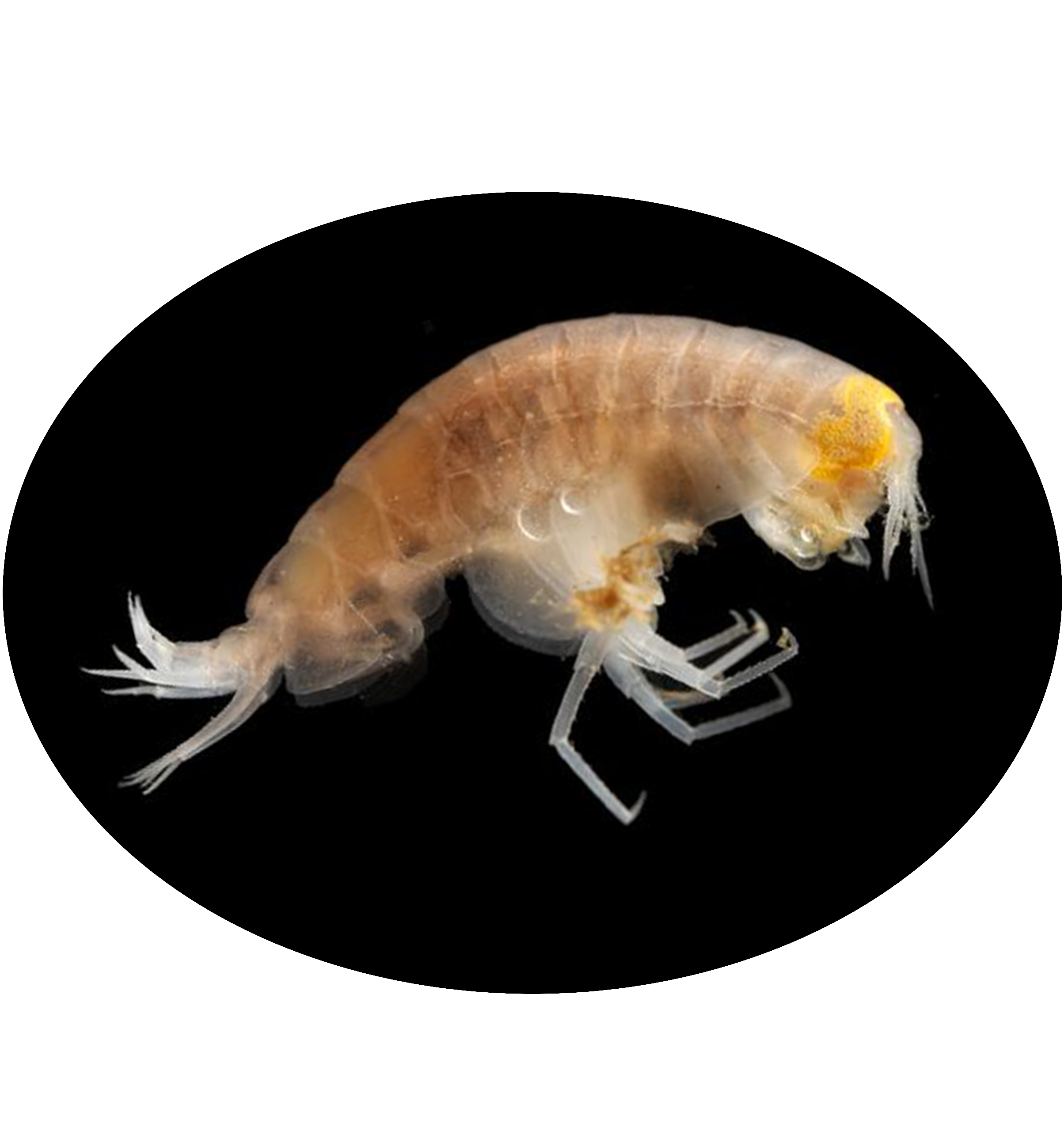
Hirondellea gigas is a species of amphipod crustacean found in the hadal zone of the Pacific Ocean, particularly in the Mariana Trench. It is adapted to extreme deep-sea environments, living at depths exceeding 10,000 meters where pressures are immense and temperatures are near freezing. This species feeds on organic matter that sinks to the ocean floor, playing a crucial role in the deep-sea ecosystem as a scavenger. Its unique adaptations, such as a lightweight exoskeleton and specialized enzymes, allow it to survive and thrive in one of the most extreme habitats on Earth.
Animalia (Kingdom); Arthropoda (Phylum); Crustacea (Subphylum); Multicrustacea (Superclass); Malacostraca (Class); Eumalacostraca (Subclass); Peracarida (Superorder); Amphipoda (Order); Amphilochidea (Suborder); Lysianassida (Infraorder); Lysianassidira (Parvorder); Lysianassoidea (Superfamily); Hirondelleidae (Family); Hirondellea (Genus); Hirondellea gigas (Species)
Tetronychia gigas Birstein & M. Vinogradov, 1955
Philippine Trench from Philippine Sea, Mariana Trench from North Pacific Ocean and Kuril-Kamchatka Trench
| Species | Phylum | Common Name | Ecosystem | Depth | Habitat | NCBI Taxonomy ID |
|---|---|---|---|---|---|---|
| Hirondellea gigas | Arthropoda | - | Deep sea | 6,800-11,000 | Mariana Trench in the northwestern Pacific Ocean | 1518452 |
| Genome Assembly | Genome Size | Assembly level | Released year | WGS accession | Submitter | BioProject | BUSCO completeness (%) | Scaffold/Contig N50 (kb) | GC content (%) | Repeat Rate (%) | Gene Number |
|---|---|---|---|---|---|---|---|---|---|---|---|
| - | 13.92Gb | Chromosome | 2025 | CNA0142381 | - | CNP0005374 | 89.34 | 458,700/466.1 | 38.8 | 72.75 | 27,881 |
| Title | Journal | Pubmed ID |
|---|---|---|
| The amphipod genome reveals population dynamics and adaptations to hadal environment | Cell | 40054448 |
| Gene ID | Description |
|---|---|
| Hgig_17547 | |
| Hgig_17548 | PHOSPHOLIPASE D |
| Hgig_17549 | PHOSPHOLIPASE D |
| Hgig_17550 | TRANSPOSASE-RELATED |
| Hgig_17551 | |
| Hgig_17552 | RIKEN CDNA 9930021J03 GENE |
| Hgig_17553 | NEURABIN |
| Hgig_17554 | DIACYLGLYCEROL KINASE |
| Hgig_17555 | DIACYLGLYCEROL KINASE |
| Hgig_17556 | |
| Hgig_17557 | NEUROLIGIN |
| Hgig_17558 | |
| Hgig_17559 | TRANS-SULFURATION ENZYME FAMILY MEMBER |
| Hgig_17560 | IONOTROPIC RECEPTOR 20A-RELATED |
| Hgig_17561 | TRANS-SULFURATION ENZYME FAMILY MEMBER |
| Hgig_17562 | RHO GUANINE NUCLEOTIDE EXCHANGE FACTOR |
| Hgig_17563 | |
| Hgig_17564 | CARBONIC ANHYDRASE |
| Hgig_17565 | CARBONIC ANHYDRASE |
| Hgig_17566 | |
| Hgig_17567 | METALLOPROTEASE |
| Hgig_17568 | |
| Hgig_17569 | RNA EXONUCLEASE REXO1 / RECO3 FAMILY MEMBER-RELATED |
| Hgig_17570 | |
| Hgig_17571 | UPF0545 PROTEIN C22ORF39 |
| Hgig_17572 | |
| Hgig_17573 | HAT FAMILY DIMERISATION DOMAINCONTAINING PROTEIN-RELATED |
| Hgig_17574 | CBP/P300-RELATED |
| Hgig_17575 | CBP/P300-RELATED |
| Hgig_17576 | KINETOCHORE-ASSOCIATED PROTEIN 1 |
| Hgig_17577 | KINETOCHORE-ASSOCIATED PROTEIN 1 |
| Hgig_17578 | |
| Hgig_17579 | STAR-RELATED LIPID TRANSFER PROTEIN 9 |
| Hgig_17580 | |
| Hgig_17581 | DNA-BINDING PROTEIN INHIBITOR |
| Hgig_17582 | PROTEASE FAMILY M14 CARBOXYPEPTIDASE A,B |
| Hgig_17583 | NUCLEAR HORMONE RECEPTOR HR3-RELATED |
| Hgig_17584 | UNCHARACTERIZED |
| Hgig_17585 | AGAP002036-PA |
| Hgig_17586 | |
| Hgig_17587 | NUCLEAR HORMONE RECEPTOR HR3-RELATED |
| Hgig_17588 | PHOSPHATIDYLINOSITOL GLYCAN |
| Hgig_17589 | ATILLA, ISOFORM B-RELATED-RELATED |
| Hgig_17590 | CENTROSOME-ASSOCIATED PROTEIN 350 |
| Hgig_17591 | |
| Hgig_17592 | |
| Hgig_17593 | COILED-COIL DOMAIN-CONTAINING PROTEIN 102A |
| Hgig_17594 | ACYL-COA SYNTHETASE |
| Hgig_17595 | |
| Hgig_17596 | PHOSPHOINOSITIDE-SPECIFIC PHOSPHOLIPASE C FAMILY PROTEIN |

